Peugeot 508 2014 Owner's Manual - RHD (UK, Australia)
Manufacturer: PEUGEOT, Model Year: 2014, Model line: 508, Model: Peugeot 508 2014Pages: 352, PDF Size: 13.51 MB
Page 201 of 352
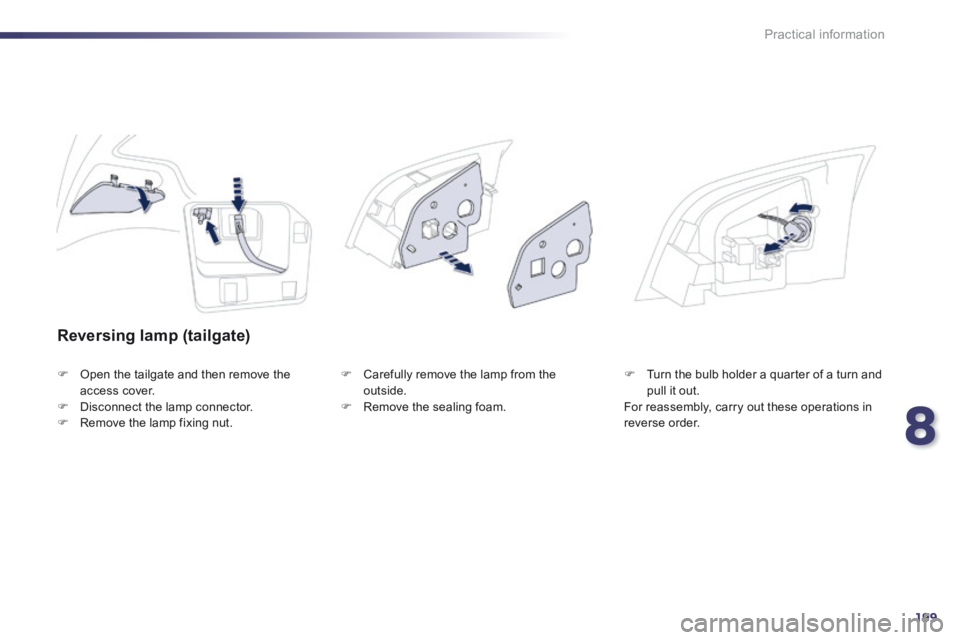
8
199
Practical information
Reversing lamp (tailgate)
Open the tailgate and then remove the access cover. Disconnect the lamp connector. Remove the lamp fixing nut.
Carefully remove the lamp from the outside. Remove the sealing foam.
Turn the bulb holder a quarter of a turn and pull it out. For reassembly, carry out these operations in reverse order.
Page 202 of 352
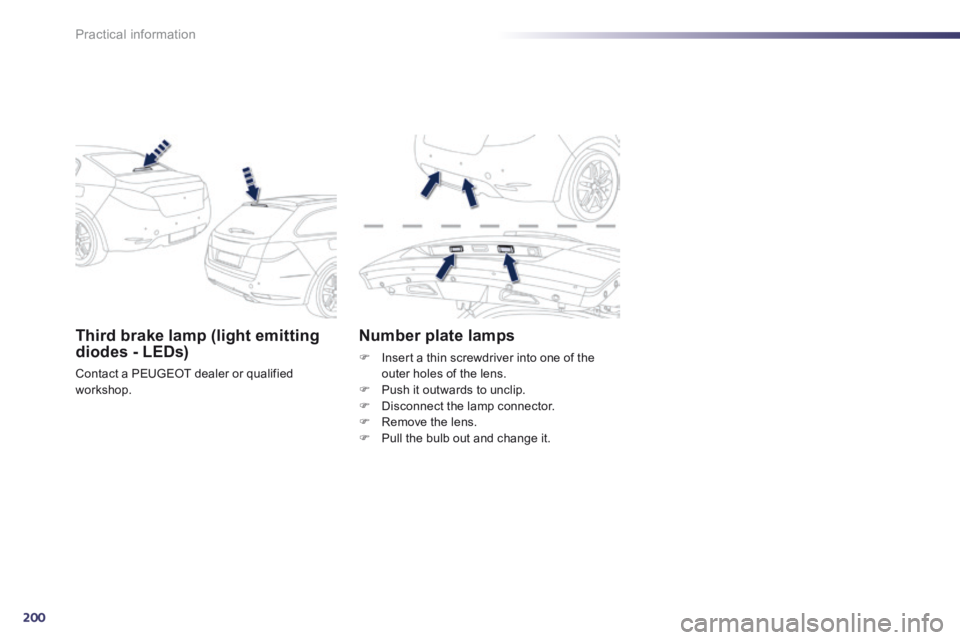
200
Practical information
Third brake lamp (light emitting diodes - LEDs)
Contact a PEUGEOT dealer or qualified workshop.
Number plate lamps
Insert a thin screwdriver into one of the outer holes of the lens. Push it outwards to unclip. Disconnect the lamp connector. Remove the lens. Pull the bulb out and change it.
Page 203 of 352
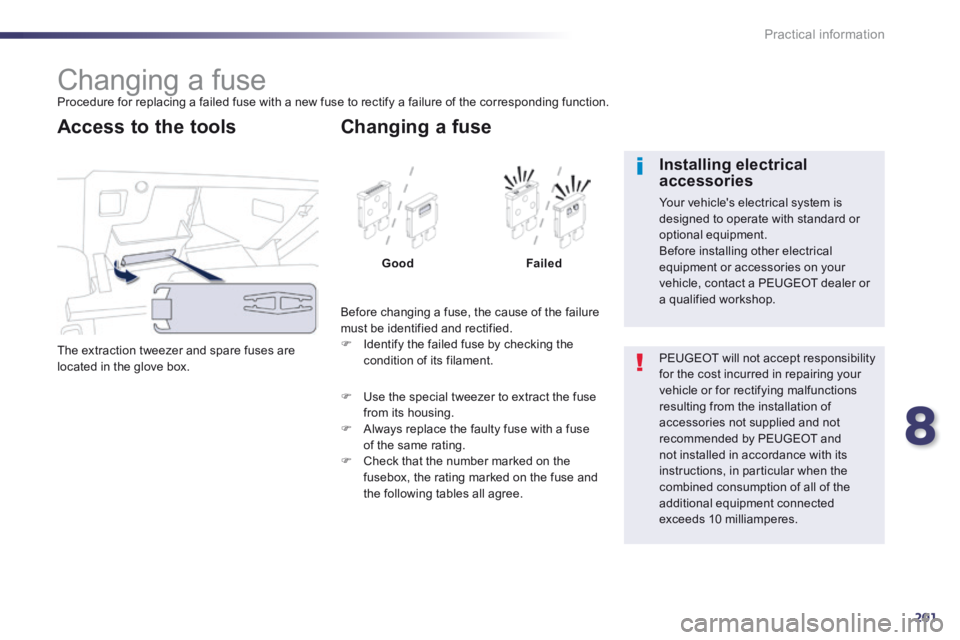
8
201
Practical information
Changing a fuse Procedure for replacing a failed fuse with a new fuse to rectify a failure of the corresponding function.
The extraction tweezer and spare fuses are located in the glove box.
Access to the tools
Before changing a fuse, the cause of the failure must be identified and rectified. Identify the failed fuse by checking the condition of its filament.
Changing a fuse
GoodFailed
Use the special tweezer to extract the fuse from its housing. Always replace the faulty fuse with a fuse of the same rating. Check that the number marked on the fusebox, the rating marked on the fuse and the following tables all agree.
PEUGEOT will not accept responsibility for the cost incurred in repairing your vehicle or for rectifying malfunctions resulting from the installation of accessories not supplied and not
recommended by PEUGEOT and not installed in accordance with its instructions, in particular when the combined consumption of all of the additional equipment connected exceeds 10 milliamperes.
Installing electrical accessories
Your vehicle's electrical system is designed to operate with standard or optional equipment. Before installing other electrical equipment or accessories on your vehicle, contact a PEUGEOT dealer or a qualified workshop.
Page 204 of 352
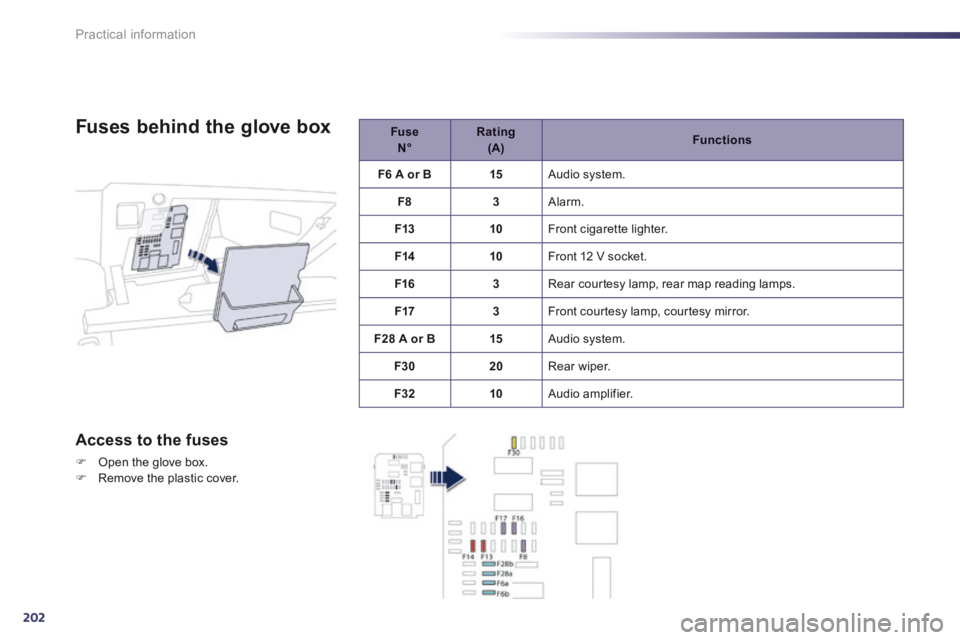
202
Practical information
Fuses behind the glove box
Access to the fuses
Open the glove box. Remove the plastic cover.
Fuse N° Rating (A) Functions
F6 A or B 15 Audio system.
F8 3 Alarm.
F13 10 Front cigarette lighter.
F14 10 Front 12 V socket.
F16 3 Rear courtesy lamp, rear map reading lamps.
F17 3 Front courtesy lamp, courtesy mirror.
F28 A or B 15 Audio system.
F30 20 Rear wiper.
F32 10 Audio amplifier.
Page 205 of 352
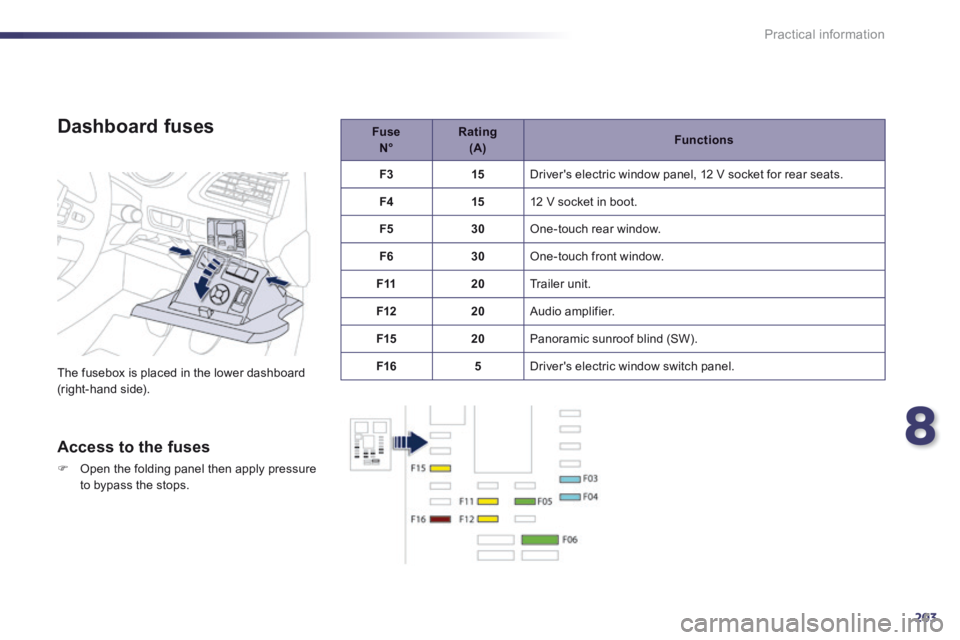
8
203
Practical information
Dashboard fuses
The fusebox is placed in the lower dashboard (right-hand side).
Access to the fuses
Open the folding panel then apply pressure to bypass the stops.
Fuse N° Rating (A) Functions
F3 15 Driver's electric window panel, 12 V socket for rear seats.
F4 15 12 V socket in boot.
F5 30 One-touch rear window.
F6 30 One-touch front window.
F11 20 Trailer unit.
F12 20 Audio amplifier.
F15 20 Panoramic sunroof blind (SW).
F16 5 Driver's electric window switch panel.
Page 206 of 352
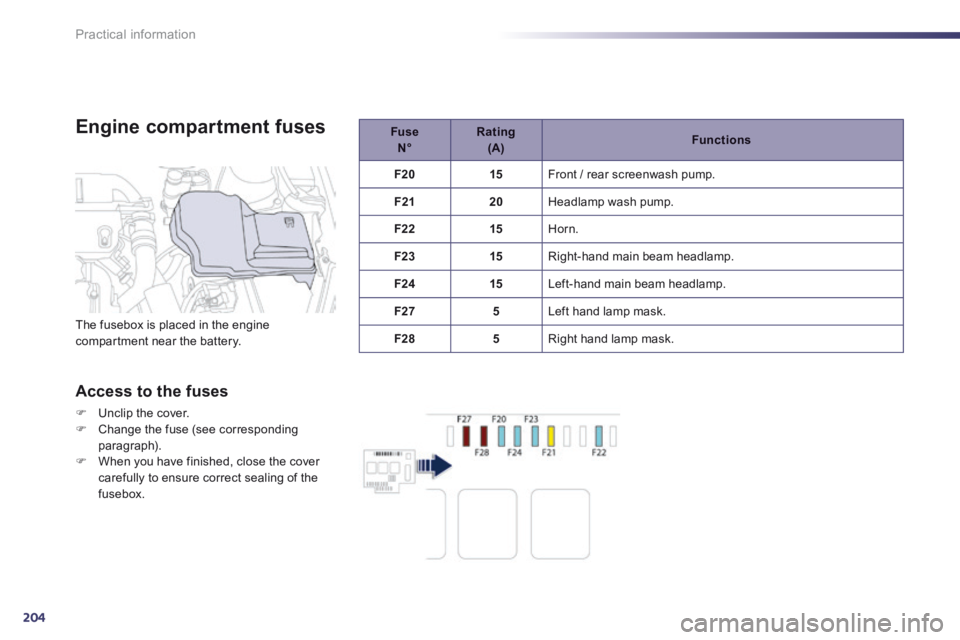
204
Practical information
Engine compartment fuses Fuse N° Rating (A) Functions
F20 15 Front / rear screenwash pump.
F21 20 Headlamp wash pump.
F22 15 Horn.
F23 15 Right-hand main beam headlamp.
F24 15 Left-hand main beam headlamp.
F27 5 Left hand lamp mask.
F28 5 Right hand lamp mask. The fusebox is placed in the engine compartment near the battery.
Access to the fuses
Unclip the cover. Change the fuse (see corresponding paragraph). When you have finished, close the cover carefully to ensure correct sealing of the
fusebox.
Page 207 of 352
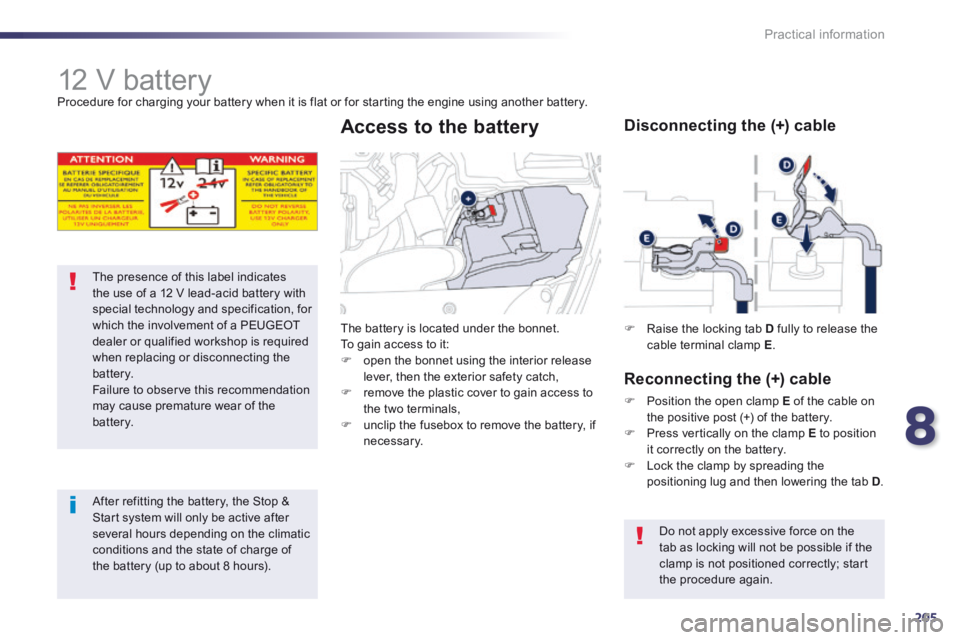
8
205
Practical information
12 V battery Procedure for charging your battery when it is flat or for starting the engine using another battery.
The presence of this label indicates the use of a 12 V lead-acid battery with special technology and specification, for which the involvement of a PEUGEOT dealer or qualified workshop is required when replacing or disconnecting the battery. Failure to observe this recommendation may cause premature wear of the battery.
After refitting the battery, the Stop & Start system will only be active after several hours depending on the climatic conditions and the state of charge of the battery (up to about 8 hours).
The battery is located under the bonnet. To gain access to it: open the bonnet using the interior release lever, then the exterior safety catch, remove the plastic cover to gain access to the two terminals, unclip the fusebox to remove the battery, if
necessary.
Access to the battery
Raise the locking tab D fully to release the cable terminal clamp E .
Disconnecting the (+) cable
Reconnecting the (+) cable
Position the open clamp E of the cable on the positive post (+) of the battery.
Press vertically on the clamp E to position it correctly on the battery. Lock the clamp by spreading the positioning lug and then lowering the tab D .
Do not apply excessive force on the tab as locking will not be possible if the clamp is not positioned correctly; start the procedure again.
Page 208 of 352
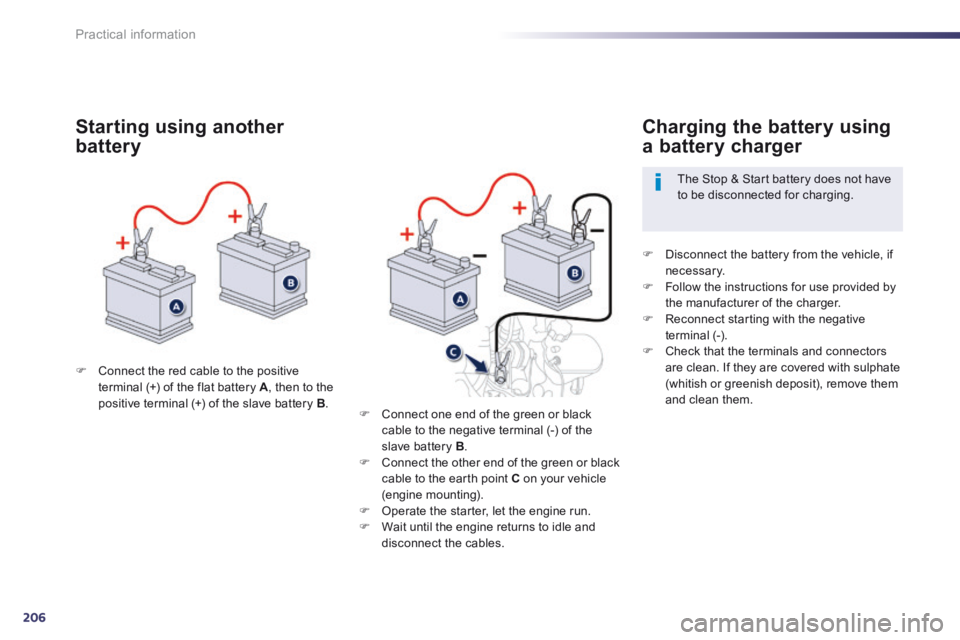
206
Practical information
Connect the red cable to the positive terminal (+) of the flat battery A , then to the positive terminal (+) of the slave battery B .
Starting using another
battery
Disconnect the battery from the vehicle, if necessary. Follow the instructions for use provided by the manufacturer of the charger. Reconnect starting with the negative terminal (-). Check that the terminals and connectors are clean. If they are covered with sulphate (whitish or greenish deposit), remove them and clean them.
Charging the battery using
a battery charger
The Stop & Start battery does not have to be disconnected for charging.
Connect one end of the green or black cable to the negative terminal (-) of the slave battery B . Connect the other end of the green or black cable to the earth point C on your vehicle (engine mounting). Operate the starter, let the engine run. Wait until the engine returns to idle and disconnect the cables.
Page 209 of 352
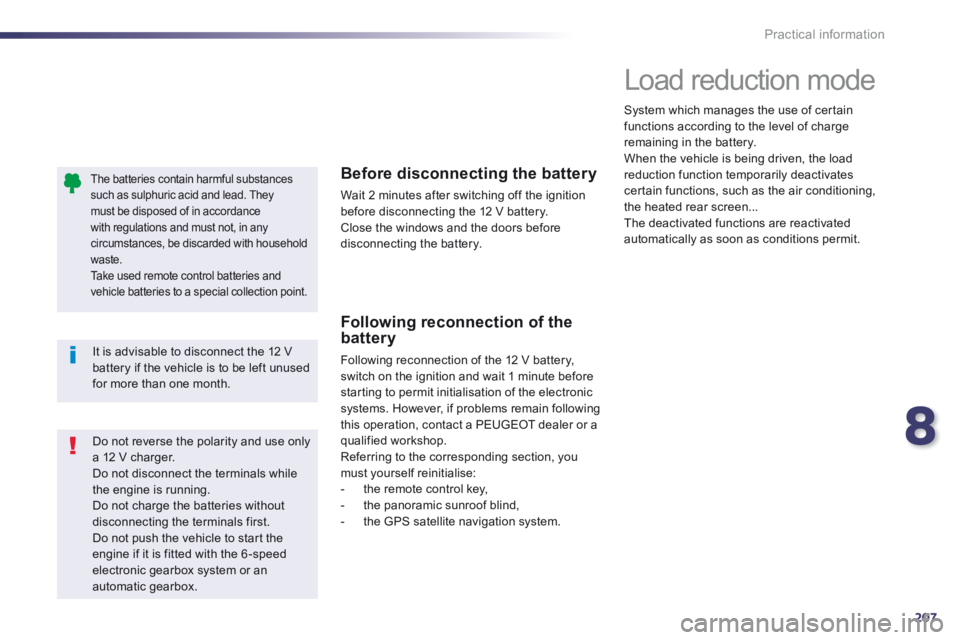
8
207
Practical information
The batteries contain harmful substances such as sulphuric acid and lead. They must be disposed of in accordance with regulations and must not, in any circumstances, be discarded with household waste. Take used remote control batteries and vehicle batteries to a special collection point.
Do not reverse the polarity and use only a 12 V charger. Do not disconnect the terminals while the engine is running. Do not charge the batteries without disconnecting the terminals first. Do not push the vehicle to start the engine if it is fitted with the 6 -speed electronic gearbox system or an
automatic gearbox.
It is advisable to disconnect the 12 V battery if the vehicle is to be left unused for more than one month.
Before disconnecting the battery
Wait 2 minutes after switching off the ignition before disconnecting the 12 V battery.
Close the windows and the doors before disconnecting the battery.
Following reconnection of the battery
Following reconnection of the 12 V battery, switch on the ignition and wait 1 minute before starting to permit initialisation of the electronic systems. However, if problems remain following this operation, contact a PEUGEOT dealer or a qualified workshop. Referring to the corresponding section, you must yourself reinitialise: - the remote control key, - the panoramic sunroof blind, - the GPS satellite navigation system.
Load reduction mode
System which manages the use of certain functions according to the level of charge remaining in the battery. When the vehicle is being driven, the load reduction function temporarily deactivates certain functions, such as the air conditioning, the heated rear screen... The deactivated functions are reactivated automatically as soon as conditions permit.
Page 210 of 352

208Practical information
System which manages the duration of use of certain functions to conserve a sufficient level of charge in the battery. After the engine has stopped, you can still use functions such as the audio and telematics system, windscreen wipers, dipped beam headlamps, courtesy lamps, etc. for a maximum combined duration of about forty minutes.
Energy economy mode
Switching to economy mode
A message then appears in the instrument panel screen indicating that the vehicle has switched to economy mode and the active functions are put on standby. If a telephone call is being made at this time, it
will be maintained for around 10 minutes with the Bluetooth hands-free system of your audio system.
Exiting economy mode
These functions are reactivated automatically next time the vehicle is driven. In order to resume the use of these functions immediately, start the engine and let it run: - for less than ten minutes, to use the equipment for approximately five minutes, - for more than ten minutes, to use the equipment for up to approximately thirty minutes. Let the engine run for the duration specified to ensure that the battery charge is sufficient. Do not repeatedly and continuously restart the engine in order to charge the battery. A flat battery prevents the engine from starting (refer to the "Battery" section).